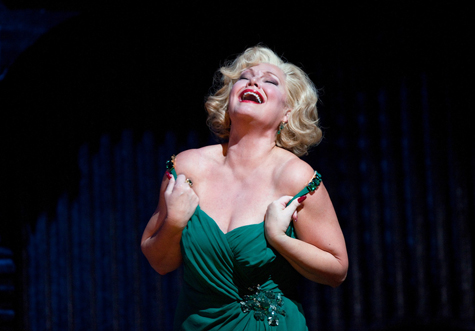
NOT READY FOR HD But Karita Mattila's performance in The Makropulos Case was one of the best things the Met presented all season — in any media.
|
A couple of weeks ago I wrote a piece about the Met in HD, the low-cost screenings of live Metropolitan Opera productions in movie theaters around the world. Last week, I went to the Met to see two productions that were not telecast: Benjamin Britten's Billy Budd and Leos Janácek's The Makropulos Case, revivals of two of my favorite 20th-century operas. I guess these productions are either too old or not popular enough for HD, yet they were by quite some margin the best Met productions I saw this year, designed not for the TV camera but for an opera house, superbly conducted, gorgeously played, and cast with singing actors whose thrilling unamplified voices filled the house like forces of nature.
Finnish soprano Karita Mattila, for example, was Elina Makropulos, alias Emilia Marty, the 300-year-old diva, immortal like the heroine H. Rider Haggard's She, who needs to find the formula for eternal life before her time runs out. The 1926 opera, is based on a 1922 play by Karel Capek (whose earlier R.U.R. introduced the present meaning of the word "robot"); the composer served as his own librettist. Mattila, with a blond Marilyn Monroe hairdo, is a sumptuously glamorous woman whose voice still projects molten heat and a platinum gleam. Not a syllable gets lost.
This is a true diva opera — there's no point in doing it without a star of Mattila's magnitude. In Boston, in 1986, the legendary Anja Silja, made an indelible impression in one of Sarah Caldwell's greatest critical successes. Mattila, singing in Czech, in a theater far larger than Caldwell's Opera House, was not as nuanced as Silja, who burned with a mesmerizing inner fire. But like Silja, Mattila was having fun playing a diva. Her Emilia enjoys name-dropping, even when the people whose names she drops are long dead (she even mocks the vocal ability of a famous soprano of the previous century). Her vamp (short for "vampire") is amused by her own role-playing, until she becomes disgusted with it.
The production, designed by Elijah Moshinsky in 1996, is semi-expressionistic, beginning with one of the rarest settings for an opera scene — a law office. On one side there's a nearly three-story high window at a steep rakish slant, and in the back a wall of file drawers climbing into the rafters. The second act is the deserted backstage of a production of Aida, with a giant Sphinx dominating the set. The third act is Marty's fashionable hotel suite, the great window now looming at the rear of the set.
The major miscalculation of the production is that during the most dramatic scene in this act, a confrontation between Marty and her antagonists, a drop curtain comes down and the confrontation takes place in front of it. It looks cheesy. You know that some complicated set change is occurring. The weak minimal staging diminishes the importance of this crucial scene, making it secondary to the inevitable stage effect you know will materialize when the drop curtain will rise again. It's a high price to pay for what turns out to be a spectacular effect. The fiancée of the young man who has committed suicide over Marty burns the document with the secret formula, and — poof! — the whole room ignites, framed with flames as Marty dies — her magnified ghostly image now visible through the huge window.